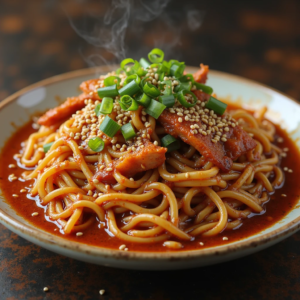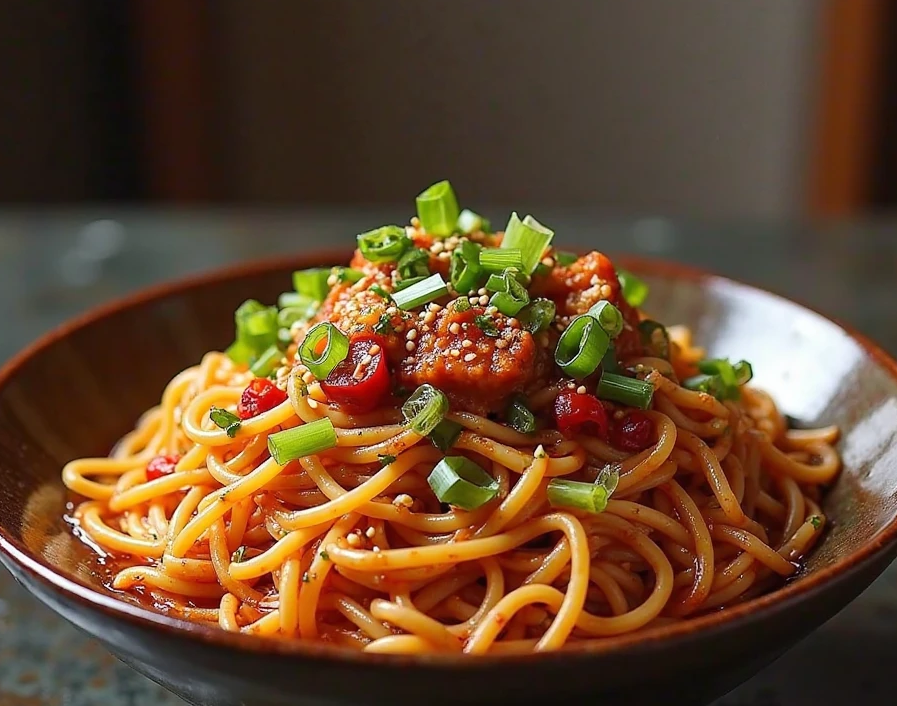Let me paint you a picture: it’s 2 AM, you’re standing in your kitchen in pajamas, slurping noodles straight from the bowl because you literally cannot stop eating them. That’s the power of properly made Dan Dan noodles. This isn’t just another noodle recipe – it’s a life-changing experience wrapped in Sichuan peppercorns and chili oil.
I’ve been perfecting this Dan Dan noodles recipe for years, and I’m convinced it’s the closest you can get to authentic Chengdu street food without hopping on a plane to China. The combination of nutty tahini, fiery chili oil, and that distinctive tingle from Sichuan peppercorns creates something that’s simultaneously comforting and electrifying.
What Makes Dan Dan Noodles So Special?
Dan Dan noodles (担担面) originated from street vendors in Sichuan province who carried their entire kitchen setup on bamboo poles – “dan dan” literally refers to these carrying poles. What started as humble street food has become one of China’s most beloved noodle dishes, and for good reason.
The magic lies in the sauce. It’s a masterclass in flavor balance: the nuttiness of tahini or sesame paste, the heat from chili oil, the numbing sensation of Sichuan peppercorns, and just enough sweetness to tie everything together. When you toss hot noodles with this sauce, something magical happens – each strand gets coated in this incredible flavor bomb that hits every taste bud.
Ingredients That Make the Difference
For the Aromatic Pork Topping:
- ½ lb ground pork (or substitute with beef, chicken, or crumbled tofu)
- 1 tbsp finely chopped garlic (about 3 cloves)
- 1 tsp fresh ginger, minced
- 1 tbsp soy sauce
- 1 tbsp Shaoxing wine, dry sherry, or rice wine
- Pinch of freshly ground black pepper
- 1 tbsp neutral cooking oil
- 2 oz Chinese preserved mustard greens, chopped (optional but authentic)
Legendary Sauce:
- 1 tsp minced garlic (about 2 cloves)
- 2 tbsp high-quality tahini (preferably made with toasted sesame seeds) or natural peanut butter
- 1½ tbsp light soy sauce
- 1 tsp dark soy sauce (for color and depth)
- 3 tbsp chili oil with chili flakes
- 1-3 tsp ground Sichuan peppercorns (adjust to taste)
- ½ tbsp sugar
Assembly:
- 2 portions fresh egg noodles or good-quality spaghetti
- Handful of yu choy, bok choy, or napa cabbage
- 3 tbsp prepared sauce per serving
- ¼ cup hot chicken or vegetable broth per serving
- Chopped green onions for garnish
- Crushed peanuts or sesame seeds for finishing

The Step-by-Step Journey to Noodle Nirvana
Preparing the Aromatic Pork
The pork topping isn’t just protein – it’s a flavor enhancer that adds richness and texture to every bite. Start by heating your wok or large skillet over medium-high heat. Add the oil and let it shimmer.
Add the minced garlic and ginger, stirring constantly for about 30 seconds until fragrant. The aroma should fill your kitchen – that’s when you know you’re on the right track.
Add the ground pork, breaking it up with your spatula. Cook for 3-4 minutes until it starts browning. Now comes the flavor building: add the soy sauce, Shaoxing wine, and black pepper. Continue cooking until the pork is fully cooked and slightly caramelized, about 2-3 more minutes.
If using preserved mustard greens, add them now and stir-fry for another minute. The pickled vegetables add an authentic tangy note that cuts through the richness beautifully. Set aside and keep warm.
Creating the Soul of the Dish: The Sauce
This sauce is where Dan Dan noodles separate themselves from every other noodle dish on the planet. In a medium bowl, start with the tahini or peanut butter. If it’s thick, loosen it slightly with a teaspoon of warm water.
Add the minced garlic, both soy sauces, and sugar. Whisk until smooth. Now for the star players: slowly drizzle in the chili oil while whisking. You want the oil to emulsify with the tahini, creating a glossy, cohesive sauce.
Finally, add the ground Sichuan peppercorns. Start with 1 teaspoon if you’re new to this spice – it creates a unique numbing sensation called “má” that’s essential to authentic Sichuan cuisine. You can always add more next time if you want more tingle.
The sauce should be thick but pourable. If it’s too thick, thin it with a little hot broth or warm water. If it’s too thin, add more tahini. Taste and adjust – it should be intensely flavorful since it’s going to flavor all those noodles.
Noodle Cooking Mastery
Fresh egg noodles are traditional, but good-quality spaghetti works surprisingly well. The key is cooking them just until al dente – they’ll finish cooking when you toss them with the hot sauce.
Bring a large pot of salted water to a rolling boil. Add your noodles and cook according to package directions, minus about 30 seconds. In the last minute of cooking, add your greens to blanch them quickly.
Reserve about ½ cup of the starchy pasta water before draining – this liquid gold will help the sauce cling to the noodles perfectly.
The Grand Assembly
Here’s where the magic happens. Have your serving bowls ready and warmed if possible. Place about 3 tablespoons of sauce in each bowl. Add ¼ cup of hot broth to each bowl and whisk to combine – this loosens the sauce and creates the perfect consistency.
Add the hot, drained noodles and greens to each bowl. Using chopsticks or tongs, toss vigorously for at least 30 seconds. Every strand should be coated in that gorgeous, glossy sauce. If the mixture seems dry, add a splash of the reserved pasta water.
Top with the aromatic pork, chopped green onions, and a sprinkle of crushed peanuts or sesame seeds. Serve immediately while everything is steaming hot.
Pro Tips for Dan Dan Perfection
Toast your Sichuan peppercorns: Buy whole peppercorns and toast them in a dry pan for 2-3 minutes until fragrant, then grind them yourself. The difference in flavor is remarkable.
Quality chili oil matters: Look for chili oil that includes the sediment and flakes at the bottom. That’s where much of the flavor lives. Lao Gan Ma or homemade chili oil work beautifully.
Temperature is everything: This dish must be served hot. Warm your bowls, work quickly during assembly, and eat immediately. Cold Dan Dan noodles lose their soul.
Customize your heat level: The beauty of making this at home is controlling the spice level. Start conservatively with the chili oil and Sichuan peppercorns, then build up your tolerance over time.
Ingredient Substitutions That Actually Work
No tahini? Natural peanut butter works, though the flavor will be slightly different. Some recipes actually prefer peanut butter for its creaminess.
Missing Sichuan peppercorns? While they’re irreplaceable for authentic flavor, you can substitute with a small amount of white pepper mixed with a tiny pinch of ground cloves.
Preserved mustard greens: Kimchi (rinsed), pickled radish, or even sauerkraut can provide similar tangy contrast.
Shaoxing wine: Dry sherry or mirin work as substitutes, though cooking wine from the grocery store is fine too.
The Cultural Connection
Every time you make Dan Dan noodles, you’re participating in a culinary tradition that spans centuries. Street vendors in Chengdu still serve versions of this dish, and the technique you’re using in your kitchen connects you to countless cooks who’ve perfected this recipe over generations.
The interplay of flavors – the “má là” (numbing and spicy) sensation that defines Sichuan cuisine – represents a sophisticated understanding of how different taste sensations can work together rather than compete.
Storage and Meal Prep
While Dan Dan noodles are best enjoyed fresh, you can prep components ahead. The sauce keeps in the refrigerator for up to a week and actually improves as flavors meld. The cooked pork mixture can be stored for 3-4 days.
For quick weeknight meals, cook a double batch of pork and freeze half. The sauce can be made in larger quantities and portioned into ice cube trays for single servings.
Never store the assembled dish – the noodles will absorb the sauce and lose their texture. Always assemble just before serving.
Why This Recipe Will Ruin You for Other Noodles
Fair warning: once you master this Dan Dan noodles recipe, you’ll find yourself comparing every other noodle dish to it. The complex interplay of flavors, the satisfying richness, and that addictive Sichuan peppercorn tingle create something that’s genuinely hard to stop eating.
I’ve served this to friends who claimed they didn’t like spicy food, only to watch them scrape every last drop of sauce from their bowls. There’s something about the combination of heat, nuttiness, and umami that transcends typical spice tolerance.
The best part? Once you have the technique down, this comes together in about 20 minutes. It’s fast enough for a weeknight dinner but impressive enough for entertaining.
Final Thoughts
Dan Dan noodles represent everything I love about great cooking: simple techniques that create complex flavors, ingredients that transform when combined, and a dish that’s somehow both comforting and exciting.
This recipe has earned its place in my regular rotation not just because it tastes incredible, but because it never gets old. Each bowl delivers that same excitement, that same “holy cow, this is amazing” moment that made me fall in love with it in the first place.
Make this recipe, but don’t say I didn’t warn you about the addiction that follows. You might find yourself making excuses to cook it “just one more time” far more often than you’d care to admit.
